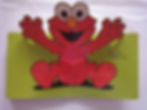Reading with your child: Starting out
CVI Scotland have written an excellent article, 'Reading To Your Child', where different families share their experiences of what books have come to mean to them. The article delivers the message beautifully that there is no right or wrong way to enjoy books with your child, and that books can bring something to the life of every child, even to those with the most severe CVIs.
Cerebral visual impairments present in ways as unique as the individuals themselves. There are, however, often commonalities as to the way visual material needs to be presented in order to maximise it's accessibility.
The below in an overview of some general approaches and tips that should be useful as a starting point to help your child to access and enjoy books. Clearly, if you've already started to build up a more personalised idea of your child's visual behaviour, then use what you know, and disregard anything that isn't relevant.
1/ Choosing books with the best pictures
-
Simple, block colour illustrations
-
Plain backgrounds
Red and yellow are often mentioned as colours of high interest to children with CVIs, alongside (or even more so than) black and white. However, if (like me) you have no clue what your child's preferred colour is, then the general principle of bold, high saturation colour (i.e. avoid pastels, shading, sketchy drawing etc) is a good starting point.
Children with CVIs may or may not have reduced visual acuity. Either way, thick bold outlines can help by maximising contrast with the (hopefully) plain background.
Movement also often gives increased visual interest to CVI kids, so pop-outs, as well as any shiny or sparkly effects on images may be helpful as this basically mimics movement.


Elmo, from 'So Big!', by Anna Jane Hays
2/ Simplify what's going on in their peripheral vision
'Minimising background clutter' is a phrase we often hear in relation to CVIs. So remember, it is not just the picture backgrounds that should be as plain as possible, but what the child can see in their peripheral vision, i.e. the opposite page of the book, and what is going on behind the book.
There is an excellent article from CVI Scotland that makes a very clear case for the importance of reducing peripheral background clutter.
To block out the opposite page from the one your child is currently viewing, you can hold a plain piece of cardboard over it, or if a book is a particular favourite, then you might want to invest the time in taping in some additional plain pages. This is particularly helpful if other people are going to be reading with your child so that you don't have to give them any instructions in order to get it right.


Plain black pages inserted to hide the opposite page from view
(from 'A Busy Day for Birds', by Lucy Cousins)
For what is going on behind the book, you could try the the following:
-
Reading bedtime stories with a plain duvet cover as a background
-
Creating a plain reading corner (both wall and floor coverings)
-
Covering a large piece of cardboard in black material for resting the book on when cuddling on the sofa
3/ Size of image
This may or may not be important to your child, but if you think that it is, then be aware that different versions of the same book may be in quite different sizes, for example, paperbacks often seem to be bigger than board books. A limited number of titles also have giant size 'classroom editions'.
4/ The danger of very dull books...
Just because a book has 'perfect' images from a CVI-perspective, doesn't make it a good book! There are some quite mind-numbingly badly written children's books out there.
There is a strong argument for choosing books with fabulous words, and if the pictures are inaccessible to your child, ignoring them completely. For example, my son loves 'Wriggle and Roar' by Julia Donaldson. It's frankly hard to see how the illustrations could be much worse from a CVI-perspective, but I can still read him the poems (by sneakily glancing at the book over his shoulder), whilst acting out the actions with gusto. Don't let your child be deprived of the best books, just because the pictures don't work for you.
If you do, however, come across a book with perfect illustrations but uninspiring text, then change it up. Tell your own story, or, if they are able, get your child to make up their own and 'read' the book to you.